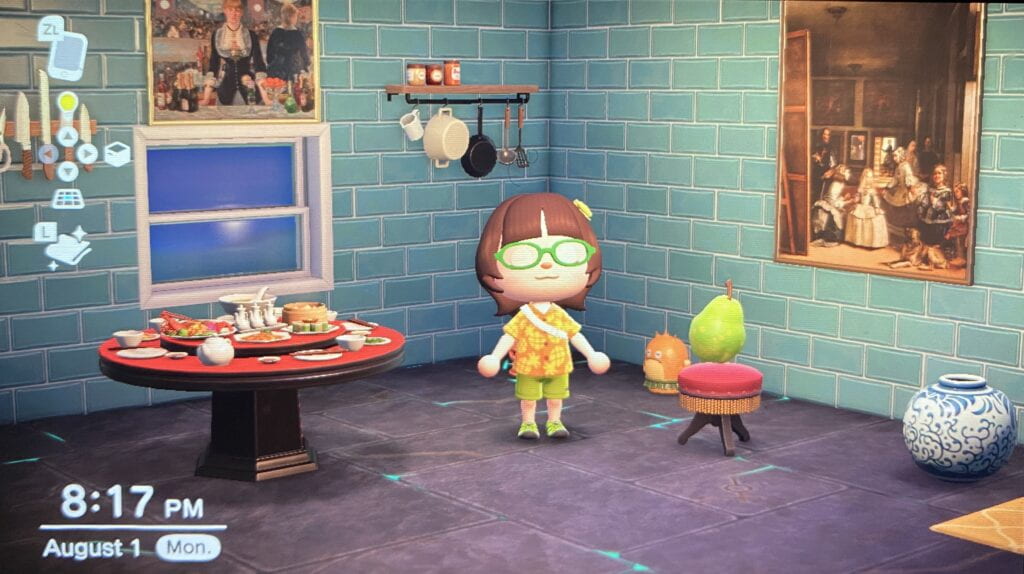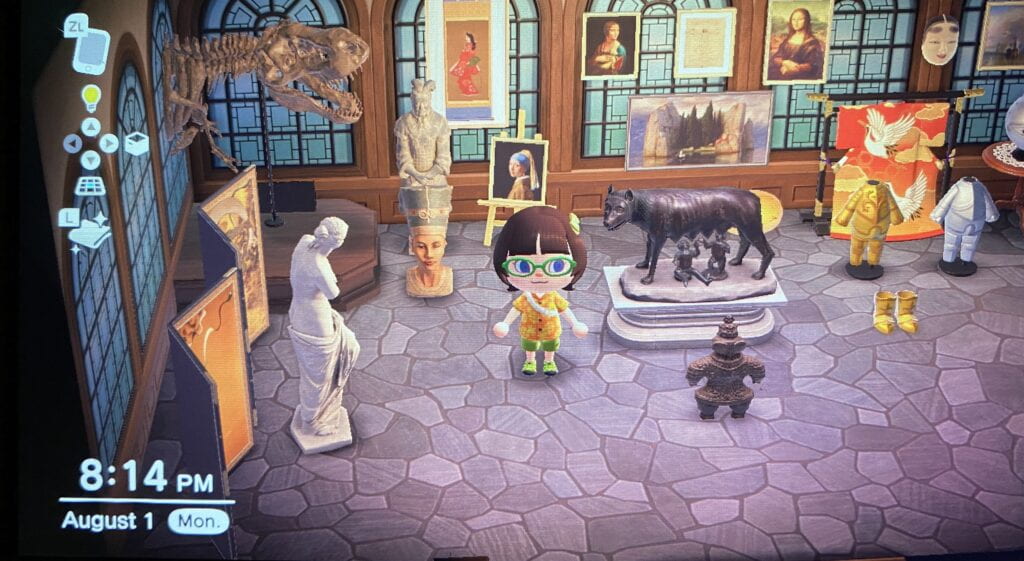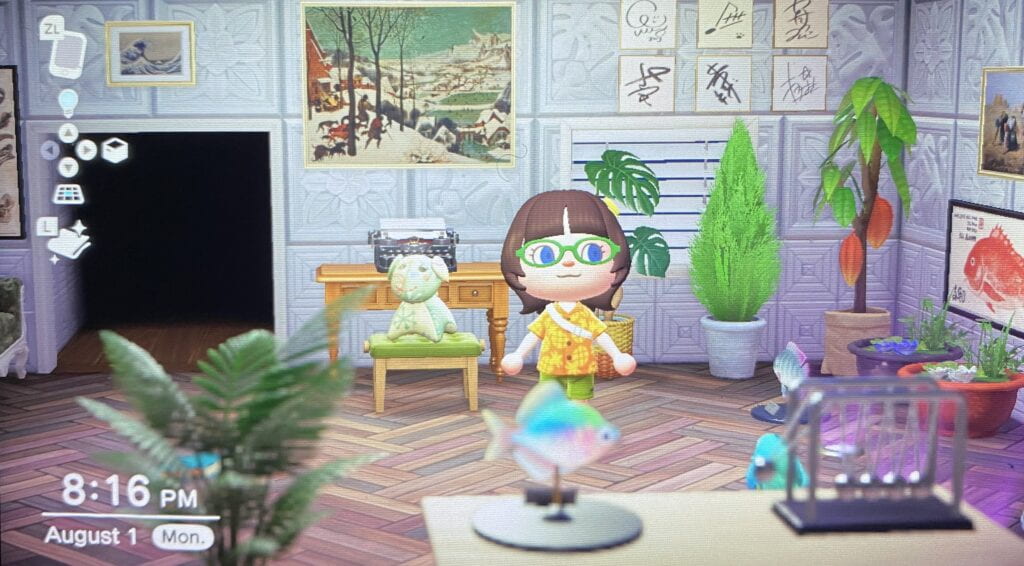I’m really into art crime: I have informed, well-considered, capital-T Thoughts about the Isabella Stewart Gardener Museum heist and Hannah Arendt’s report on books and silver that the Nazis appropriated before deporting their rightful owners and other things as well. It’s interesting in all the parts of my brain, but with an edge. In another lifetime, if I hadn’t been an academic, and if my plan B weren’t driving a snowplow for the city and curating the Department of Sanitation’s in-house museum during the months when it’s not snowing, then I think I might have liked to join the FBI’s art crime squad. Highbrow, interesting, multi-sensory, but with an edge and a goal. I have an assignment for my honors students where I ask them to plan a heist in the Islamic Art galleries at the Met. It’s a way to get them to start asking why? without me having to be pedantic about it: an edge and a goal.
Like a lot of other people, I fell into the Zeitgeist and played Animal Crossing every day for over a year at the start of the pandemic. Totally lowbrow. I had to get over my primal fear of raccoons, as they are the characters who are in charge of the construction company that your character works for in the game, building up an island village inhabited by you and a bunch of animal non-player characters. I am so afraid of raccoons that I was perfectly prepared not to play a game features even cute cartoon ones. It helped when someone explained to me that these overlords are really tanooki, a kind of Japanese dog known for their enormous testicles and otherwise looking like long, skinny raccoons. They are dogs but they are called raccoons in the English version of the game, although the Japanese name is why it’s slightly funny that the chief raccoon-dog is called Tom Nook. Tom-Nook-i. Tanooki. Get it? So, there’s Tom Nook and a very enthusiastic Shi-Tzu named Isabelle who makes daily announcements for the residents and is responsible for putting up the Christmas lights all over your island and definitely got turned into a Bernie Sanders meme after Joe Biden’s inauguration — this is ridiculous. I know. But it’s a game that can be played online and you can “visit” other players’ islands and I needed a way to stay connected to friends during the lockdown.
There’s also a pirate, a fox named Redd, who pilots a smog-belching fishing trawler called the Jolly Redd from which he overcharges for home goods and — and I promise I’m coming to the point — sells works of art priced out in the local currency. Some of the paintings and statues are real and some of them are faked. So Redd might be selling Vermeer’s “Girl with the Pearl Earring” as Vermeer painted it, or he might be selling a similar canvas but the girl’s earring is star-shaped instead of round. It’s up to you to discern the reals from the fakes, buy the reals, and then donate them to the art and natural history museum that’s directed by an owl who loves fossils but is disgusted by bugs, whose sister is into astrology, and who is friends with the pigeon who runs the museum café. There are all kinds of player guides for the game online, including some about the art. It always feels a little like cheating to go straight there than to try to figure out myself what the painting is, then go to the real museum’s web site where the real painting really is, and see if I can spot the differences myself. I absolutely go straight to the player’s guides so I can buy the art and keep playing. What I don’t do is donate my purchases to the museum. Instead, I play as a criminal art dealer who matches Redd in shadiness.My in-game basement is full of Vermeers, Breughels, Seargents, Da Vincis (the fake “Vitruvian Man” has a coffee ring on it, which I find charming), Turners, as well as classical sculpture in monochrome and Japanese block-prints. The whole, full-sized “Las Meninas” is hanging in my in-game kitchen, Velázquez next to Pissarro and Cezanne, next to my digital stove and fridge and table.


I’ve been playing this game (less so now, but I was) and thinking about how it changes the ways we look at art, or at least how those of us who were playing it obsessively during the pandemic look at art. What does it mean to scrutinize the shade of purple of a tree not because the purple itself is interesting but because if it’s redder than it should be, then the work is a fake. What is a fake in this context, when it has been invented for a particular game and has no relationship to a forgery or a reproduction or a souvenir out in the world? It’s a harmless digital fake of a digital reproduction that claims in-game authenticity. You might, inexplicably, get the opportunity to buy multiple copies of the authentic “Girl with the Pearl Earring” (the fox is, don’t forget, a pirate), so how do artistic workshops and the art market function in the world of the game?
And what does all of this do to the possibility of ekphrasis? What happens when there are eight famous poems about “The Hunters in the Snow” but the version we keep encountering has the dogs in the foreground removed to serve the profit interests of a fox made of light? What is the work of art in an age of mechanical reproduction that makes the Mona Lisa look much more surprised than she did when she was spirited out of the Louvre in 1911 — the theft that made the painting famous — or covered with whipped cream last year as part of a labor action? How do you read that first chapter of Les mots et les choses when the guy in Velázquez’s studio doorway is pointing at the king and queen and not just looking at them? Is there even meaning here, or have I lost my mind after all this pandemic-time inside my own head and become a parody of myself?

I’m fascinated with cartoons and defacements of art meeting in this way and I want to write about it, but I feel like I’d have to read quite a lot of art theory and criticism before doing that and I don’t have the will or brain power for it, at least not right now. I’m burned out from writing prose but all I’m good at is writing prose. I’m burned out from research, but the personal essay is overdone so I’ll never get to explore these ideas except in poetry. Plus, the moment for Animal Crossing has really passed. But every time I sit down and try to write a kind of surrealist prose poem about this, it requires so much setup that it ends up being like flash fiction except I don’t write fiction because I can’t swing a plot. I’m burned out and I have a genre problem and this is all ridiculous anyway.

